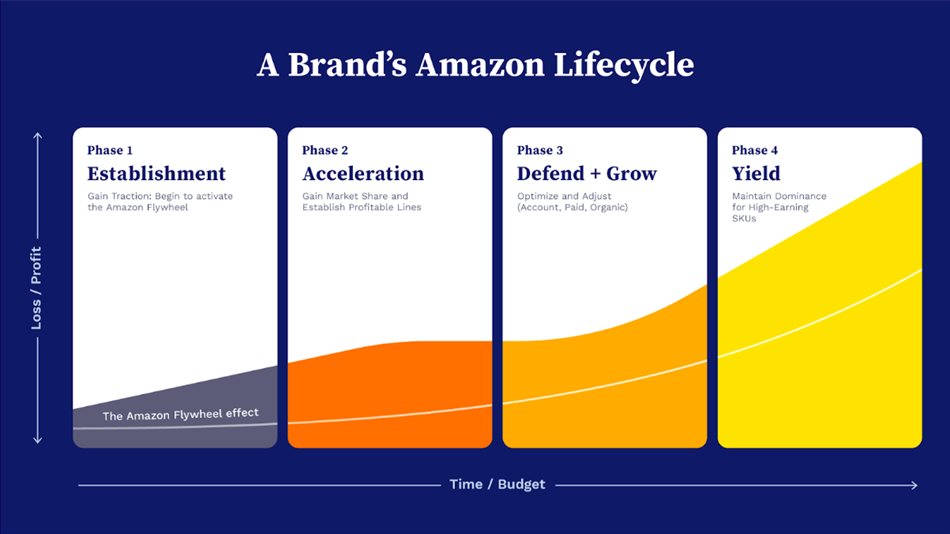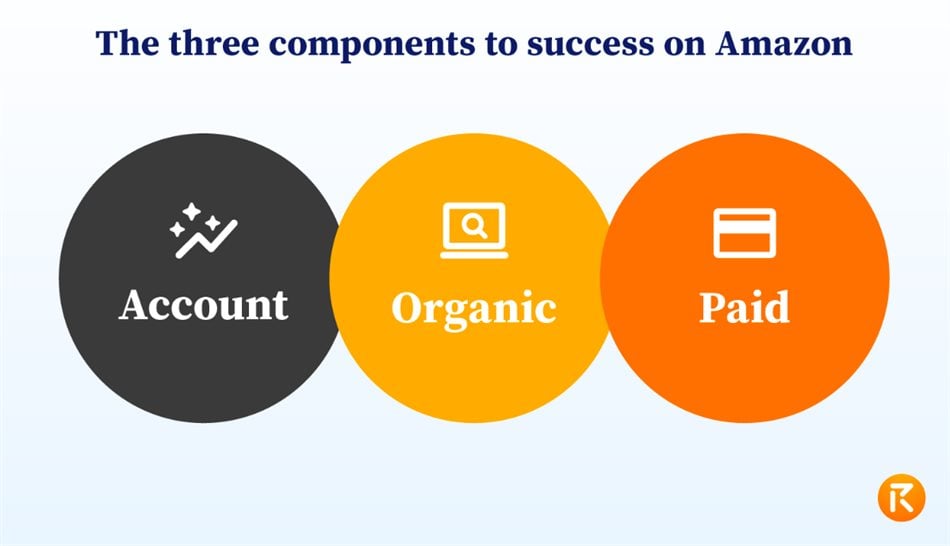Below details the four key phases a brand will typically experience on their Amazon journey. The rate and degree of success comes down to time, budget, a deep understanding of the platform and the Amazon algorithm, as well as constant effort. All of these, and a great product, which will determine your success on Amazon.
We will guide you through the four phases and highlight the actions necessary to maximise your profitability on the platform.
Phase 1: Establishment
Objective: Gain traction
During this initial phase, focus on establishing a solid foundation for your brand. Here are key actions to take:
- Competitor and product research: Thoroughly research your competitors and analyse the market to identify gaps and opportunities. Understand customer preferences and the competitive landscape.
- Niche analysis: Identify a specific niche within your market that aligns with your brand's strengths and target audience.
- Product development and selection: Create unique Amazon-only SKUs that cater to the needs and preferences of your target audience.
- Keyword research: Conduct keyword research to optimise your product listings for better visibility in search results.
- Asset creation of conversion-optimised listings: Create compelling and informative product titles, descriptions, and high-quality images to attract customers and increase conversion rates.
- Reviews strategy – Vine: Develop a strategy to generate initial reviews for your products, leveraging Amazon's Vine programme and other review generation tactics.
- Brand strategy – Store/A+: Build a brand presence on Amazon by leveraging features such as Amazon Stores and Enhanced Brand Content (A+ Content).
- Stock strategy – hybrid/vendor/seller/FBA/direct fulfilment: Determine the most suitable fulfilment method(s) for your products, considering factors like scalability, cost-effectiveness, and customer expectations.
- Pricing strategy: Develop a pricing strategy that positions your products competitively while maintaining profitability.
- Launch strategy: Plan a strategic product launch, including timing, promotions, and advertising campaigns.
- Paid social campaigns for audience analysis: Utilise paid social campaigns to gather valuable audience insights, allowing you to refine your targeting on Amazon.

- Testing and learning philosophy: Adopt a mindset of continuous testing and learning, using data-driven insights to optimise your strategies.
Phase 2: Acceleration
Objective: Gain market share and establish profitable lines
In this phase, focus on expanding your market share and establishing profitable product lines. Consider the following actions:
- Advertising investment: Increase your advertising budget to drive targeted traffic and increase sales velocity.
- Market share focus: Identify key competitors and products within your niche to target for increased market share.
- Continuous SEO focused on competitors: Regularly optimise your listings and content to stay ahead of competitors in search rankings.
- Driving up BSR (best sellers rank): Implement strategies to boost your products' BSR, such as promotions, pricing optimisation, and advertising campaigns.
- Reviews focus on building brand presence: Continue generating positive reviews to build trust and establish your brand's presence on Amazon.
- Target specific competitors and products: Develop targeted advertising campaigns aimed at specific competitors and their products to increase visibility and market share.
- Social listening: Monitor social media platforms and customer feedback to identify trends, customer preferences, and potential areas for improvement.
- Affiliates: Explore opportunities to collaborate with affiliates who can promote your products to their audience, expanding your reach.
- Consider hybrid: Evaluate the benefits of a hybrid approach, combining vendor and seller strategies, to maximise profitability.
Phase 3: Defend + Grow
Objective: Optimise and Adjust
During this phase, your focus shifts to optimising your brand's performance and defending your market position. Consider the following actions:
- DSP (demand-side platform): Leverage Amazon's DSP to reach a broader audience and drive targeted advertising campaigns.
- Catalogue management: Regularly review and manage your product catalogue, introducing new products or retiring underperforming ones.
- Audit resellers and focus on buy-box retention: Monitor resellers and take necessary actions to maintain control over the buy box, ensuring a competitive advantage.
- Split variations to drive down competitors: Strategically split product variations to reduce the number of competitors appearing in search results.
- Advertising defensive tactics: Implement defensive advertising strategies to protect your market share from competitors.
- Editorials: Utilise Amazon's editorial opportunities to showcase your brand and products through relevant content.
- Special events: Participate in special events and promotions to generate buzz and drive sales.
- New markets: Explore opportunities to expand into new markets or target new customer segments to fuel growth.
Phase 4: Yield
Objective: Maintain dominance for high-earning SKUs
In the final phase, your focus is on maintaining dominance for your high-earning SKUs while proactively monitoring the market. Consider the following actions:

- DSP: Continue leveraging Amazon's DSP to maintain a competitive edge and maximise reach.
- Manage successful listings and products with day-to-day tactics: Implement day-to-day tactics, such as dayparting and price optimisation, to ensure continued success for your top-performing listings and products.
- Monitor new brands and products entering the niche and adjust immediately: Stay vigilant and adapt quickly to changes in the market, such as new brands or products entering your niche. Adjust your keywords, pricing, and unique selling propositions (USPs) accordingly.
- Pricing strategy – variable pricing: Utilise variable pricing strategies to maintain a healthy sales velocity while maximising profitability.
- Optimised SKUs using visual SEO: Continuously optimise your SKUs by incorporating visual SEO elements such as compelling images and videos.
By understanding the different phases of the Amazon brand lifecycle and implementing the corresponding actions, you can accelerate your brand's growth and profitability on the platform. It typically takes around 18 months to mature into Phase 4, but an aggressive advertising strategy with larger budgets can speed up this process. Stay initiative-taking, adapt to market changes, and continually optimise your strategies to maintain a dominant position and achieve long-term success on Amazon.
The Amazon Flywheel effect and then pulling the correct “levers” of the Amazon algorithm is constant effort through all phases.
If you would like expert guidance on optimising your brand's presence on Amazon, feel free to reach out to us at moc.latigid7tr@tcatnoc. We are here to help you.
Here are the links to the episodes now available across multiple channels: https://youtu.be/GreEHoYU1As
